- Home
- Encyclopedia
- Tracy McCraken: From a $3,000 Loan To a Newspap...
Tracy McCraken: From a $3,000 Loan to a Newspaper Empire
When Tracy McCraken borrowed $3,000 in June 1926 to buy the Wyoming Eagle newspaper in Cheyenne, it was the best financial move he ever made. The young journalist gradually bought a chain of papers throughout the state, creating what rival publishers called a newspaper empire.
McCraken, a 32-year-old Illinois native, had been a reporter, editor and ultimately publisher of the Laramie Boomerang. He had graduated from the University of Wyoming with a journalism degree in 1917, and met his wife, Lillian, two years later when both were on the Boomerang staff.
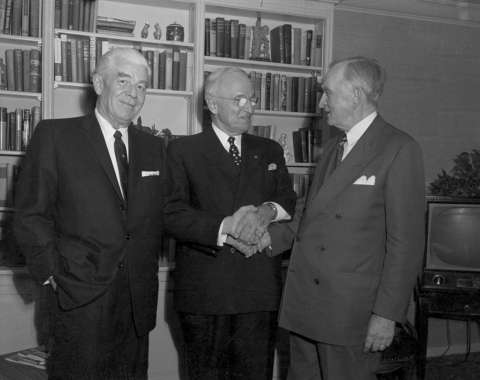
By the time he bought the Eagle, he had also served as executive secretary for Gov. William B. Ross and U.S. Sen. John B. Kendrick. The latter, one of McCraken's mentors, encouraged him to buy the struggling weekly Eagle, at that time one of the few editorially Democratic newspapers in the state.
Eying profits and politics
McCraken not only made the Eagle profitable, but he turned it into a free daily in 1933. Within a year he was charging his 7,000 subscribers a nickel a week for home delivery.
Why would readers want to pay for something they obtained for free? Because McCraken was smart enough not to give everything away. He started cartoons and serials in the free edition of the Eagle and continued them in a four-page insert readers had to buy if they wanted to see what happened. Additional content included editorials and major news stories of the day.
In 1937 he bought his larger capital city competition, the Wyoming Tribune, and merged it with the Eagle. McCraken used the Tribune's more modern printing plant to crank out copies of both.
Though McCraken was a staunch Democrat, he kept the Tribune's editorial policy Republican, which led to the unusual situation of having the Eagle opining in favor of Democrats in the morning and the Tribune expressing opposite GOP views in the afternoon—both under the same roof.
Throughout his publishing career McCraken was a tremendous force in Wyoming Democratic politics, serving as the party's chairman before becoming its national state committeeman from 1942 to 1960. At the Democratic National Convention in Los Angeles July 12, 1960 he capped his political career by casting all of the Wyoming delegation's 15 votes for U.S. Sen. John F. Kennedy of Massachusetts, putting him over the top as the party's presidential nominee.
Building a newspaper chain
McCraken's path to his brief national spotlight was paved by shrewd business skills and political influence during his newspaper career. In 1938 he and a former University of Wyoming classmate, C. Stanley Greenbaum, started the McCraken chain of Wyoming newspapers outside of the capital city when they bought the Laramie Boomerang. In 1939 he and another partner, Ted O'Melia, purchased the Worland Grit and renamed it the Northern Wyoming Daily News.
McCraken became a true media mogul in 1940 when he began operating KFBC radio station and knocked his only Cheyenne competition out of business within six months. While commercial radio was introduced to Wyoming in 1930, Cheyenne didn’t have a station until October 1940. Three months later KFBC went on the air and six months after that, McCraken’s competition folded.
Dec. 7, 1941, will always be remembered as a day of infamy with the attack on Pearl Harbor, but it was also the day McCraken acquired and merged the Rock Springs Rocket and the Rock Springs Miner papers. The purchase was made with yet another partner, David Richardson.
McCraken completed the five-newspaper chain, which was called Cheyenne Newspapers, Inc., when he and O'Melia bought the Rawlins Daily Times in 1946. By the time he died in 1960, the chain reportedly was worth $750,000.
McCraken decided to get into the new television business by starting KFBC-TV in 1954. In 1969, nine years after his death, the media monopoly he created and left to his family caught the attention of the U.S. Justice Department. Officials questioned the fairness of a company owning both newspapers, the capital city radio and TV stations in the same market and filed an antitrust lawsuit. The action was settled in 1970 when the company agreed to sell the TV station.
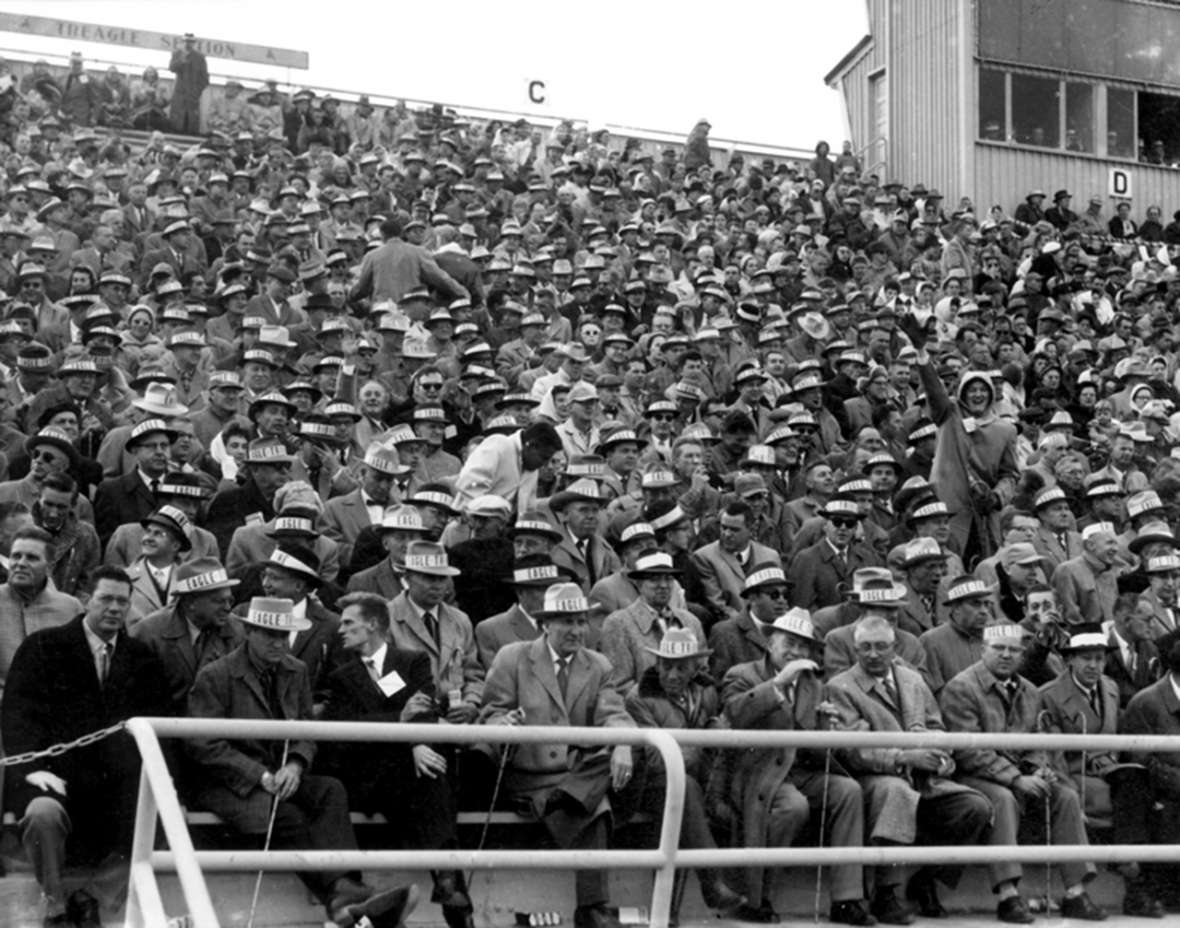
Women not allowed on Treagle train
As a newspaper owner, McCraken never lacked for promotional ideas. His most famous was a train that carried his top advertising customers and news sources the 50 miles to Laramie once a year for lunch and a University of Wyoming Cowboys football game. Originally called the "Eagle Special" when it began in 1935, the train became known as the "Treagle"—a combination of his newspapers' names—after McCraken bought the Tribune.
The Treagle made the annual round trip from Cheyenne to Laramie until 1979, interrupted only for the four years during World War II. McCraken invited politicians, entertainers and other celebrities to schmooze with his local 450 guests. The lengthy list included U.S. Sen. Ted Kennedy, cowboy actor Tim McCoy, and writers James Michener and Drew Pearson.
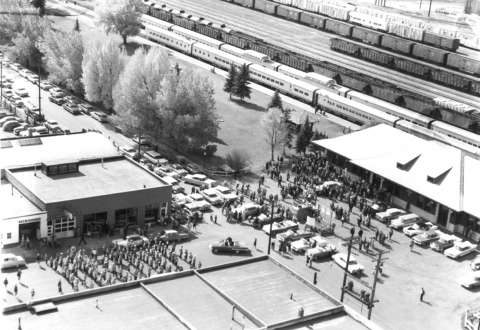
Riding the Treagle was one of the top honors for the Cheyenne business elite, and invitations were highly prized. In his book Sports in America, Michener noted that riding the Treagle train's saloon car made it a man's affair, but "important women in the state were conveyed by large buses to the game."
One enterprising female did manage to ride the Treagle surreptitiously in 1938. Irene Bohl, the Eagle's city editor, conspired with the editorial writer to sneak on the train wearing a way-too-big set of coveralls to hide her appearance.
"It was worth it," she said after the train pulled into the Laramie station. "I had the time of my life." But she worried about McCraken's reaction to her stunt. Her boss looked at her sternly at first, she thought, but then broke into a smile. Still, he later told her she was never riding the Treagle again.
Longtime Laramie resident Dennis Knight, reminiscing about 1953, was blunt about what he contended was the main purpose of the Treagle. "All the politicians and the other codgers over in the state capital ride it, and by the time the train gets to Laramie, they're fall-down drunk," he wrote. "It would be fun to hang around this afternoon and watch them get poured back onto the cars, but we gotta get on home."
McCraken's son Robert, who took over the corporation when his father died in 1960, continued the tradition until 1979, when the train made its final trip. Robert McCraken blamed the high cost of the promotion, but many people—including some women employees at the two newspapers—speculated the train's wheels ground to a halt to end the growing demands of females who wanted to be passengers.
UW searches for subversives
Tracy McCraken had a keen interest in the University of Wyoming and served on the board of trustees of the state's only university from 1943 until 1960, part of that time as vice chairman. It was in that role in 1947 that he became embroiled in one of the biggest controversies the institution has ever seen.
In the anti-Communist fervor after World War II, McCraken was strongly in favor of a UW trustees' proposal to appoint a committee to examine social sciences textbooks "to determine if such books were subversive or un-American." He was joined in his support by conservative UW President George "Duke" Humphrey. In Eagle editorials, McCraken warned that "academic freedom" could be used as an excuse for "practicing subversion."
The faculty was livid. Members voted 123-24 against the censoring board and formed its own "Committee of 15" led by History Department Chairman T.A. Larson. Students joined the intellectual fray and the campus newspaper published editorials opposing the probe.
National news accounts of the controversy led many to believe UW was a hotbed of subversives. McCraken, concerned about UW's image, arranged a meeting at Cheyenne's Plains Hotel to reach a compromise.
On the same day, UW President Humphrey announced that not a single one of the 65 textbooks examined had any examples of "subversion." The trustees abandoned the investigation and declared the principles of academic freedom would be applied at UW from that time forward. Still, McCraken and Humphrey remained active in '"anti-subversive" organizations.
McCraken wrote a weekly column, "About People and Things," for the Tribune beginning in 1955. Its tone was often folksy and its content diverse. He wrote about finally meeting his boyhood idol, baseball legend Ty Cobb. Seeing Elvis Presley on TV for the first time, McCraken made fun of squealing, swooning girls in the audience but was impressed the singer was paid $50,000 to do three Ed Sullivan shows. He put Princess Margaret, Queen Elizabeth’s sister, on a pedestal: "Frankly, we fell for her--hard," McCraken wrote.
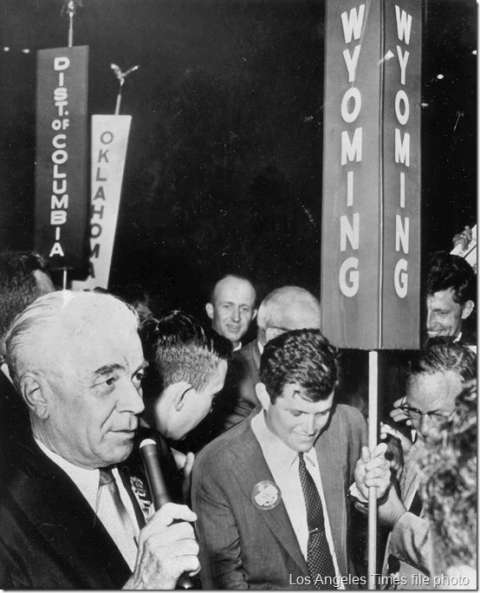
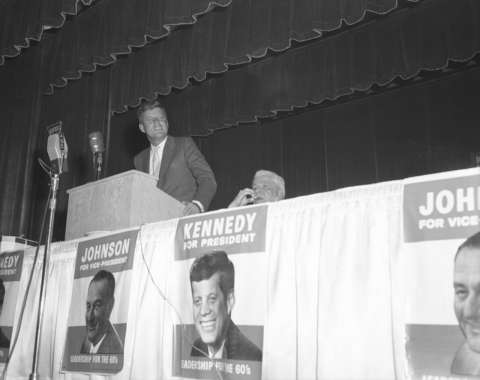
He tried to avoid writing about politics but often couldn't help himself. One of his favorite subjects was former President Harry S. Truman, who had been a guest at his Cheyenne home several times. McCraken also used his column to tell readers what really happened when, as chairman of Wyoming's Democratic delegation, he cast the historic votes that officially nominated John F. Kennedy.
McCraken 'shoots the works' for JFK
As the roll call vote at the Democratic National Convention neared Wyoming, the delegation had 10.5 votes for Kennedy and the other 4.5 votes for Lyndon B. Johnson. The story quickly spread after the convention that McCraken—knowing Kennedy needed 11 votes to win the nomination—didn't give his fellow delegates a chance to vote before he reached for the microphone and cast all 15 votes for Kennedy.
Some of Johnson's delegates were reportedly furious. Others said JFK's brother, Edward Kennedy, had been hovering near the Wyoming delegation and putting pressure on McCraken.
McCraken wrote that neither story was true. He said Ted Kennedy closely watched what the delegation was doing, but didn't interfere. McCraken explained there wasn't time for a caucus before Wyoming's turn to vote, but the delegation had talked that morning about possible scenarios.
"There was general unanimity that if we were in the position where our 15 votes would be the winning votes for any of the leading candidates, we'll shoot the works for that man," he recalled.
In his autobiography, True Compass, Ted Kennedy recalled the moment McCraken and Wyoming conveyed his brother a majority.
"It wasn't exactly soaring oratory, but it was the sweetest speech I'd ever heard," he wrote.
At breakfast the next morning, John Kennedy visited the state's delegation. He told the chairman no one in the nation was watching more intently than he was when McCraken was shown on the TV screen. "I'll be forever grateful to Wyoming and you," he said.
McCraken turns down Senate appointment
Tracy McCraken had several opportunities to become a U.S. senator, but turned them all down because he wanted to keep operating his newspaper chain.
In 1930, many Democrats in the state promoted the possibility he would seek the party's nomination for U.S. Senate, but McCraken announced he wasn't interested. "I have no such ambition," he said. "I could not afford the race if I were qualified."
In 1936, there were widespread rumors McCraken would be appointed to the Senate by the governor if the current senator, Joseph O'Mahoney, were named postmaster general. The newspaper mogul quickly dispelled that notion as well. In 1950, McCraken was formally asked to accept a Senate appointment by Gov. Lester Hunt, but he turned down the request. Hunt ended up naming himself to the Senate.
Tracy McCraken died of natural causes in Cheyenne on Dec. 26, 1960—less than a month before the inauguration of President Kennedy, the politician he helped put in the White House.
McCraken had promoted his son Robert to publisher of the Tribune and Eagle in 1957, and upon his father's death Robert was put in charge of the entire newspaper chain. After Robert McCraken died in 1989, his son Michael was first named executive editor and then publisher in 1991.
Michael McCraken continued his grandfather's tradition of making bold business moves. In 1994 he merged the two papers into the Wyoming Tribune Eagle to cut costs and avoid duplication of resources. He expanded the operation in 2007 with construction of a new state-of-the-art, $15.5 million MAN Roland press that improved color reproduction and replaced a worn-out Goss press the papers had used for decades.
The latter move occurred just prior to a national recession. "The timing was terrible for buying a new press,” McCraken admitted in a 2013 interview. “But the paper looks great.”
On Oct. 1, 2015, Cheyenne Newspapers, Inc. sold its five remaining newspapers—the Worland paper had been sold to another company in 2014—to APG Media of the Rockies LLC, a subsidiary of the Minnesota-based Adams Publishing Group, for an undisclosed price. Nearly 90 years of ownership of the Wyoming Tribune-Eagle by the McCraken family came to an end.
(Editor’s note: Publication of this and seven other articles on Wyoming newspapering is supported in part by the Wyoming Humanities Council and is part of the Pulitzer Prizes Centennial Campfires Initiative, a joint venture of the Pulitzer Prizes Board and the Federation of State Humanities Councils in celebration of the 2016 centennial of the prizes. The initiative seeks to illuminate the impact of journalism and the humanities on American life today, to imagine their future and to inspire new generations to consider the values represented by the body of Pulitzer Prize-winning work. For their generous support for the Campfires Initiative, the council thanks the Andrew W. Mellon Foundation, the Ford Foundation, Carnegie Corporation of New York, the John S. and James L. Knight Foundation, the Pulitzer Prizes Board, and Columbia University.)
Resources
Primary Sources
- Denver Post, "Power in Wyoming: Revolutionary Newspaper Ideas Behind McCraken Rise," July 13, 1952, 2AA.
- Kennedy, Edward M. True Compass: A Memoir. New York: Twelve, 2009. Accessed Jan. 14, 2016 at https://books.google.com/books?id=L1QYfgjv3mkC&pg=PT104&lpg=PT104&dq=Edward+Kennedy+True+Compass+Tracy+McCraken&source=bl&ots=TN9fiTt7ng&sig=TLXWDI1B8Y13WxJ_Yq3EH2peCz4&hl=en&sa=X&ved=0ahUKEwi78KPLuJnKAhVO22MKHeZvBmIQ6AEIHjAA#v=onepage&q=Edward%20Kennedy%20True%20Compass%20Tracy%20McCraken&f=false.
- Knight, Dennis. "Football, Autumn Leaves and Cinders Memories of Laramie, 1953," NiceStories.com, Sept. 16, 2000. Accessed Jan. 14, 2016 at http://www.nicestories.com/unreg/y/story.php?id=76.
- Laramie Boomerang, "Family-Owned Publishing Firm Purchases Local Newspaper," Oct. 2, 2015. Accessed Jan, 14, 2016 at http://www.laramieboomerang.com/news/local_news/article_efa3f9f4-68bf-11e5-a7f6-cbc1a89db116.html.
- McCraken, Tracy S. Personal Scrapbooks, vols. 1 and 2. Wyoming State Archives, Cheyenne, Wyoming.
- Wyoming Tribune-Eagle. "McCrakens had long history in Wyoming newspaper business," Oct. 2, 2015. Accessed Jan. 14, 2016 at http://www.wyomingnews.com/news/article_d1242874-7188-5e21-ad98-417542cd2ffc.html.
Secondary Sources
- Barron, Joan. "President's death hit close to home in Wyoming," Casper Star-Tribune, Nov. 22, 2013. Accessed Jan, 14, 2015 at http://trib.com/news/state-and-regional/govt-and-politics/jfk-assassination-president-s-death-hit-close-to-home-in/article_7b5edace-a31a-5f0f-b0f5-beacffaab24e.html.
- Michener, James. Sports in America. 1976. Reprint, New York: Random House Publishing Group, 2014.
- Pietrusza, David. 1960: LBJ vs. JFK vs. Nixon: The Epic Campaign that Forged Three Presidencies. Sterling Publishing Group, 2008. Accessed Jan 16, 2016 at
- https://books.google.com/books?id=Gq4c9XDOSxQC&dq=Tracy+McCraken+Wyoming&source=gbs_navlinks_s.
- Roberts, Donald. "The Federal Regulatory Agencies During The Decade Of The 1960's," Boston College Law Review 11 (Spring 2013), no. 4: 23-55.
- Roberts, Phil. A New History of Wyoming. “Chapter 17: The 1950s, Television, Yellow Stripes and Red Scare Politics.” Accessed [date here] at http://www.uwyo.edu/robertshistory/1950s_red_scare_and_yellow_stripes.htm.
- ___________. "The University of Wyoming Textbook Controversy, 1947-48.” WyoHistory.org. Accessed Jan. 14, 2016 at /essays/university-wyoming-textbook-controversy... /essays/university-wyoming-textbook-controversy-1947-48#sthash.MgefXrgp.dpuf.
- Saylor, Teri. "Rooted in the Wild West, Cheyenne newspaper forges on," National Newspapers Association, Jan. 2, 2013. Accessed Jan. 14, 2016 at http://nnaweb.org/nna-news?articleTitle=lsquo-we-rsquo-re-used-to-being-the-skunk-at-the-picnic-rsquo--1357146953--453--pub-aux-stories.
Field Trips
- The Wyoming State Archives has a collection of seven personal scrapbooks donated by Tracy S. McCraken's family. They are in two volumes on microfilm. See below for details on visiting the archives.
Illustrations
- The image of Tracy McCraken at the 1960 Democratic National Convention is a Los Angeles Times file photo. Used with thanks.
- The other photos, all by longtime Wyoming Tribune-Eagle photographer Francis Brammar, are from the collections of the Wyoming State Archives. Used with permission and thanks.
